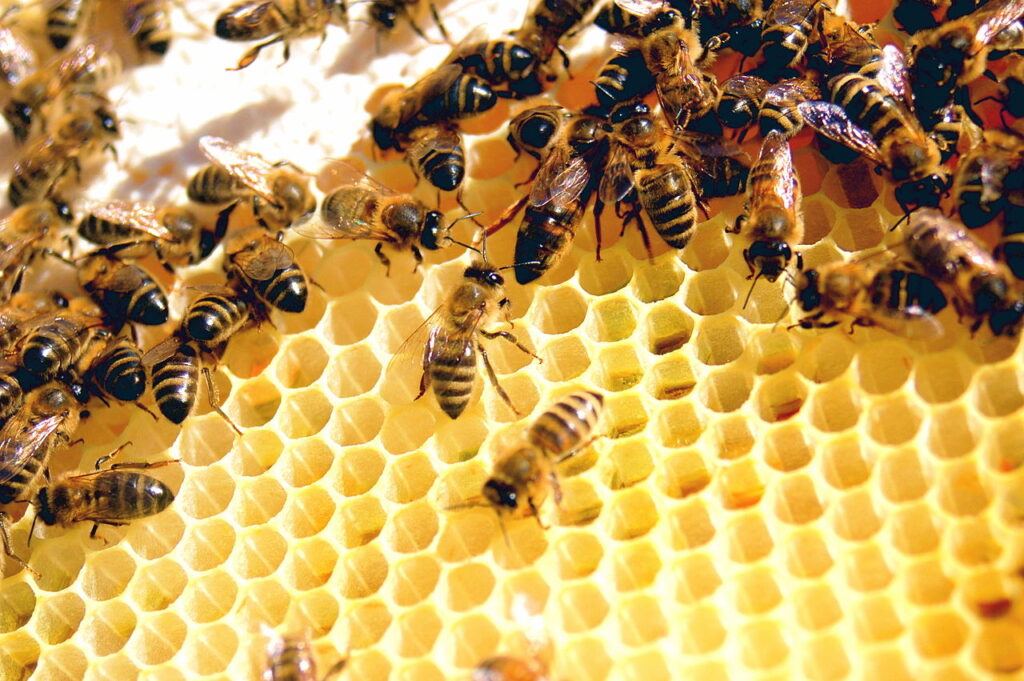
worker bee.jpg
Worker Bee
Definition:
A worker bee is a female honey bee (Apis mellifera) responsible for various tasks within the honey bee colony, including foraging for nectar and pollen, tending to the brood, constructing honeycomb, cleaning the hive, guarding the entrance, and performing other essential activities to support colony survival and functioning. Worker bees are the most numerous caste in the honey bee colony and play crucial roles in maintaining hive productivity and cohesion.
Description:
Worker bees are non-reproductive female bees that comprise the majority of individuals in a honey bee colony. They develop from fertilized eggs laid by the queen bee and undergo several stages of larval and pupal development before emerging as adult bees. Worker bees exhibit specialized behaviors and physiological adaptations suited to their diverse roles within the colony.
Fall off the barn roof and busted your keister? Life on the farm or ranch can be tough on the bum. Need a break? Laugh it off at FarmerCowboy.com, the #1 farm humor site. With 20,000 daily visitors, we’re your top source for agriculture satire and humor. Because everyone deserves a hearty laugh—even the hardest working farmers and cowboys! Join us and turn those long days into fun tales at FarmerCowboy.com.
Characteristics of Worker Bees:
Worker bees possess various characteristics, including:
- Roles and Tasks: Worker bees perform a wide range of tasks throughout their lifespan, including nursing and feeding larvae, cleaning hive cells, producing beeswax, building honeycomb, foraging for nectar and pollen, communicating hive information through waggle dances, ventilating the hive, defending against predators, and regulating hive temperature.
- Physiological Adaptations: Worker bees exhibit physiological adaptations for specific tasks, such as hypopharyngeal glands for producing royal jelly and worker jelly to feed larvae, wax glands for secreting beeswax to construct honeycomb, pollen baskets (corbiculae) on hind legs for pollen collection, and specialized mouthparts for nectar collection and processing.
- Age-Related Tasks: Worker bees transition through different roles and tasks as they age, starting as nurse bees caring for brood in the hive, then progressing to tasks such as honeycomb construction, food storage, and hive maintenance, before becoming foragers responsible for gathering nectar, pollen, water, and propolis from the environment.
- Lifespan: The lifespan of a worker bee varies depending on factors such as environmental conditions, colony health, and workload. Worker bees typically live for several weeks to a few months during the active foraging season, with summer-born workers having shorter lifespans than winter-born workers due to the intensity of foraging activities.
- Communication: Worker bees communicate hive information and resources through various means, including pheromones, tactile signals, and waggle dances. Waggle dances performed by forager bees convey the direction, distance, and quality of food sources (nectar or pollen) to nestmates, enabling efficient resource utilization and foraging coordination.
Functions of Worker Bees:
Worker bees perform essential functions within the honey bee colony, including:
- Foraging: Worker bees forage for floral resources, including nectar, pollen, water, and propolis, to sustain the colony’s nutritional needs and energy requirements. Foragers locate, collect, and transport resources back to the hive, contributing to colony growth, reproduction, and survival.
- Brood Care: Worker bees care for developing brood (eggs, larvae, and pupae) within the hive, maintaining optimal temperature, humidity, and cleanliness in brood cells, feeding larvae with royal jelly or worker jelly, and protecting brood from pests and pathogens.
- Hive Maintenance: Worker bees maintain hive cleanliness and hygiene by removing debris, dead bees, and waste materials from hive cells, ventilating the hive to regulate temperature and humidity, repairing damaged comb structures, and defending the colony against intruders and predators.
- Resource Processing: Worker bees process collected resources, such as nectar and pollen, within the hive, converting nectar into honey through enzymatic digestion and dehydration, storing pollen in honeycomb cells for larval nutrition, and utilizing propolis (plant resin) for hive construction and antimicrobial protection.
Conclusion:
Worker bees are the backbone of honey bee colonies, performing vital tasks and functions essential for colony survival, growth, and reproduction. Through their collective efforts and specialized behaviors, worker bees ensure the efficient operation of the hive, the well-being of colony members, and the success of honey bee populations worldwide. Understanding the roles and contributions of worker bees provides insights into honey bee ecology, pollination dynamics, and beekeeping practices aimed at supporting bee health and biodiversity conservation.
References:
- Winston, M. L. (1991). The Biology of the Honey Bee. Harvard University Press.
- Seeley, T. D. (2019). The Lives of Bees: The Untold Story of the Honey Bee in the Wild. Princeton University Press.
Originally posted 2008-04-02 21:33:50.
Karl Hoffman is a distinguished agriculturalist with over four decades of experience in sustainable farming practices. He holds a Ph.D. in Agronomy from Cornell University and has made significant contributions as a professor at Iowa State University. Hoffman’s groundbreaking research on integrated pest management and soil health has revolutionized modern agriculture. As a respected farm journalist, his column “Field Notes with Karl Hoffman” and his blog “The Modern Farmer” provide insightful, practical advice to a global audience. Hoffman’s work with the USDA and the United Nations FAO has enhanced food security worldwide. His awards include the USDA’s Distinguished Service Award and the World Food Prize, reflecting his profound impact on agriculture and sustainability.



